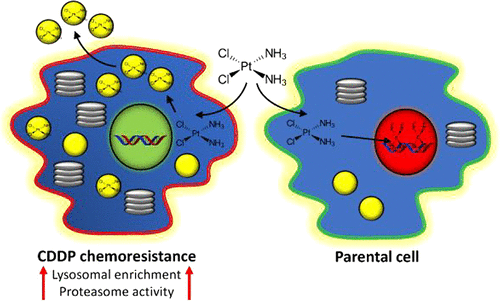当前位置:
X-MOL 学术
›
J. Proteome Res.
›
论文详情
Our official English website, www.x-mol.net, welcomes your feedback! (Note: you will need to create a separate account there.)
Proteomic Signature of Neuroblastoma Cells UKF-NB-4 Reveals Key Role of Lysosomal Sequestration and the Proteasome Complex in Acquiring Chemoresistance to Cisplatin.
Journal of Proteome Research ( IF 4.4 ) Pub Date : 2019-01-11 , DOI: 10.1021/acs.jproteome.8b00867 Miguel Angel Merlos Rodrigo 1, 2 , Hana Buchtelova 1, 2 , Vivian de Los Rios 3 , José Ignacio Casal 3 , Tomas Eckschlager 4 , Jan Hrabeta 4 , Marie Belhajova 4 , Zbynek Heger 1, 2 , Vojtech Adam 1, 2
Journal of Proteome Research ( IF 4.4 ) Pub Date : 2019-01-11 , DOI: 10.1021/acs.jproteome.8b00867 Miguel Angel Merlos Rodrigo 1, 2 , Hana Buchtelova 1, 2 , Vivian de Los Rios 3 , José Ignacio Casal 3 , Tomas Eckschlager 4 , Jan Hrabeta 4 , Marie Belhajova 4 , Zbynek Heger 1, 2 , Vojtech Adam 1, 2
Affiliation

|
Cisplatin (CDDP) is a widely used agent in the treatment of neuroblastoma. Unfortunately, the development of acquired chemoresistance limits its clinical use. To gain a detailed understanding of the mechanisms underlying the development of such chemoresistance, we comparatively analyzed established cisplatin-resistant neuroblastoma cell line (UKF-NB-4CDDP) and its sensitive counterpart (UKF-NB-4). First, using viability screenings, we confirmed the decreased sensitivity of tested cells to cisplatin and identified a cross-resistance to carboplatin and oxaliplatin. Then, the proteomic signatures were analyzed using nano liquid chromatography with tandem mass spectrometry. Among the proteins responsible for UKF-NB-4CDDP chemoresistance, ion channels transport family proteins, ATP-binding cassette superfamily proteins (ATP = adenosine triphosphate), solute carrier-mediated trans-membrane transporters, proteasome complex subunits, and V-ATPases were identified. Moreover, we detected markedly higher proteasome activity in UKF-NB-4CDDP cells and a remarkable lysosomal enrichment that can be inhibited by bafilomycin A to sensitize UKF-NB-4CDDP to CDDP. Our results indicate that lysosomal sequestration and proteasome activity may be one of the key mechanisms responsible for intrinsic chemoresistance of neuroblastoma to CDDP.
中文翻译:

神经母细胞瘤细胞的蛋白质组学特征 UKF-NB-4 揭示了溶酶体隔离和蛋白酶体复合物在获得对顺铂的化学抗性中的关键作用。
顺铂 (CDDP) 是一种广泛用于治疗神经母细胞瘤的药物。不幸的是,获得性化学抗性的发展限制了其临床应用。为了详细了解这种化学耐药性发展的潜在机制,我们比较分析了已建立的顺铂耐药神经母细胞瘤细胞系 (UKF-NB-4CDDP) 及其敏感对应物 (UKF-NB-4)。首先,使用活力筛选,我们证实了测试细胞对顺铂的敏感性降低,并确定了对卡铂和奥沙利铂的交叉耐药性。然后,使用纳米液相色谱和串联质谱法分析蛋白质组学特征。在负责 UKF-NB-4CDDP 化学抗性的蛋白质中,离子通道转运家族蛋白、ATP 结合盒超家族蛋白(ATP = 三磷酸腺苷)、确定了溶质载体介导的跨膜转运蛋白、蛋白酶体复合亚基和 V-ATPases。此外,我们在 UKF-NB-4CDDP 细胞中检测到显着更高的蛋白酶体活性和显着的溶酶体富集,可以通过巴弗洛霉素 A 抑制使 UKF-NB-4CDDP 对 CDDP 敏感。我们的结果表明,溶酶体隔离和蛋白酶体活性可能是导致神经母细胞瘤对 CDDP 产生内在化学抗性的关键机制之一。
更新日期:2019-02-07
中文翻译:

神经母细胞瘤细胞的蛋白质组学特征 UKF-NB-4 揭示了溶酶体隔离和蛋白酶体复合物在获得对顺铂的化学抗性中的关键作用。
顺铂 (CDDP) 是一种广泛用于治疗神经母细胞瘤的药物。不幸的是,获得性化学抗性的发展限制了其临床应用。为了详细了解这种化学耐药性发展的潜在机制,我们比较分析了已建立的顺铂耐药神经母细胞瘤细胞系 (UKF-NB-4CDDP) 及其敏感对应物 (UKF-NB-4)。首先,使用活力筛选,我们证实了测试细胞对顺铂的敏感性降低,并确定了对卡铂和奥沙利铂的交叉耐药性。然后,使用纳米液相色谱和串联质谱法分析蛋白质组学特征。在负责 UKF-NB-4CDDP 化学抗性的蛋白质中,离子通道转运家族蛋白、ATP 结合盒超家族蛋白(ATP = 三磷酸腺苷)、确定了溶质载体介导的跨膜转运蛋白、蛋白酶体复合亚基和 V-ATPases。此外,我们在 UKF-NB-4CDDP 细胞中检测到显着更高的蛋白酶体活性和显着的溶酶体富集,可以通过巴弗洛霉素 A 抑制使 UKF-NB-4CDDP 对 CDDP 敏感。我们的结果表明,溶酶体隔离和蛋白酶体活性可能是导致神经母细胞瘤对 CDDP 产生内在化学抗性的关键机制之一。



























 京公网安备 11010802027423号
京公网安备 11010802027423号